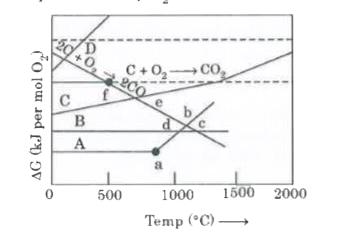A part of Ellingham diagram for some metal oxides (Based upon 1 mole of O2) and carbon is shown.

In figure A,B,C and D represent curves for metal oxides and a,b,c,d ,e and f are temperatures. Answer the following :
(i) Will B oxide reduce metal oxide of A or C or both ?
(ii) Which metal can be reduced thermally ?
(iii) Will oxide of B be reduced by coke above temperature c or below temperature c ?
(iv) Will the formation of CO or CO2 be preferred above temperature f ?
(v) What does temperature 'a' represent ?
Text Solution
(i) Metal oxide of C
(ii) Metal oxide of B
(iii) Above temperature c
(iv) CO
(v) The change in state (at fusion or vaporisation)
|
Updated on:21/07/2023
Topper's Solved these Questions
- BOOK - MODERN PUBLICATIONCHAPTER - GENERAL PRINCIPLES AND PROCESSES OF ISOLATION OF ELEMENTSEXERCISE - Conceptual Questions39videos
GENERAL PRINCIPLES AND PROCESSES OF ISOLATION OF ELEMENTS
- BOOK - MODERN PUBLICATIONCHAPTER - GENERAL PRINCIPLES AND PROCESSES OF ISOLATION OF ELEMENTSEXERCISE - NCERT FILE (Ncert In-text Questions)4videos
GENERAL PRINCIPLES AND PROCESSES OF ISOLATION OF ELEMENTS
- BOOK - MODERN PUBLICATIONCHAPTER - ELECTROCHEMISTRY EXERCISE - UNIT PRACTICE TEST20videos
ELECTROCHEMISTRY
- BOOK - MODERN PUBLICATIONCHAPTER - HALOALKANES AND HALOARENESEXERCISE - UNIT PRACTICE TEST11videos
HALOALKANES AND HALOARENES
Similar Questions
Knowledge Check
- Question 1 - Select One
Which metal oxide cannot be reduced by carbon?
APbOBAl2O3CFe2O3DZnO - Question 2 - Select One or More
Which of the following oxide cannot be reduced to metal by carbon ?
AZnOBAl2O3CCuODMgO - Question 3 - Select One
Which of the following oxide cannot be reduced to metal by carbon ?
ACuOBHgOCAl2O3DFe2O3
Which of the following metal oxides can be reduced by CO?
View SolutionWhich of the following oxide cannot be reduced to metal by carbon ?
View SolutionWhich of the following oxides cannot be reduced to metal by carbon
View SolutionWhich of the following metal oxides are reduced by Co?
View SolutionOxides that cannot be reduced by C to give the respective metal are
View Solution
